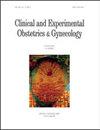Dynamic Monitoring of CD200 Mediated by Ascites-Derived Exosomes as a Predictor of Survival and Response to Front-Line Chemotherapeutics in Advanced High-Grade Serous Ovarian Cancer
IF 0.6
4区 医学
Q4 OBSTETRICS & GYNECOLOGY
引用次数: 0
Abstract
Background: Exosomes, harboring donor-cell-derived biomarkers, are implicated in transferring oncologic protein and genetic materials. CD200, an immune checkpoint, has been engineered to affect immunosuppression in ovarian cancer. However, the potential of CD200 to serve as a predictor of ovarian cancers remains unexplored. Methods: We performed dynamic measurements of exosome-mediated or serum CD200 levels at primary diagnosis, post-operation, and three cycles after chemotherapy. The receiver operating characteristic curve and cumulative survival rate were paralleled to decode the predictive and prognostic profiles. Results: Independent enrichment and identification of exosomes revealed a significant concentration of CD200, predominantly located within these exosomes. The CD200 level was elevated in non-responders compared to responders at the serial points and significantly decreased after treatment. At the 335.50 pg/mL cut-off, CD200 at primary diagnosis enabled accurate discrimination between responders and non-responders with an area under the curve (AUC) of 0.94 (95% confidence interval (CI) = 0.902–0.979, p = 0.01). With the cut-off dropping from 311.00 pg/mL to 265.00 pg/mL, the AUC decreased from 0.918 (95% CI = 0.873–0.963, p = 0.02) to 0.908 (95% CI = 0.862–0.955, p = 0.02), respectively. Elevated levels of CD200 levels at both primary diagnosis and three cycles after chemotherapy were identified as independent predictors for poor progression-free survival (PFS) (hazard ratio (HR) = 2.8, 95% CI = 2.08–3.49, p = 0.01; HR = 6.7, 95% CI = 4.01–8.02, p = 0.01, respectively) and overall survival (OS) (HR = 3.5, 95% CI = 2.14–4.99, p = 0.04; HR = 5.6, 95% CI = 3.01–7.34, p = 0.01, respectively). Based on CD200 dynamics, patients were stratified into high- and low-AUC groups. High CD200-AUC was independently associated with unfavourable PFS and OS (HR = 4.6, 95% CI = 3.6–15.7, p = 0.01; HR = 3.2, 95% CI = 1.5–6.3, p = 0.01, respectively). Conclusions: This study proposes high exosome-mediated CD200 as a liquid-based biomarker indicative of chemotolerance and dismal survival in ovarian neoplasms.动态监测腹水来源外泌体介导的CD200作为晚期高级别浆液性卵巢癌生存和一线化疗反应的预测因子
背景:外泌体含有供体细胞来源的生物标志物,与肿瘤蛋白和遗传物质的转移有关。CD200是一种免疫检查点,已被设计用于影响卵巢癌的免疫抑制。然而,CD200作为卵巢癌预测因子的潜力仍未被探索。方法:我们在初诊、手术后和化疗后三个周期对外泌体介导或血清CD200水平进行了动态测量。对照受试者工作特征曲线和累积生存率,解码预测和预后概况。结果:外泌体的独立富集和鉴定显示CD200的显著浓度,主要位于这些外泌体内。与应答者相比,无应答者的CD200水平在序列点上升高,治疗后显著降低。在335.50 pg/mL的临界值下,初诊时的CD200能够准确区分应答者和无应答者,曲线下面积(AUC)为0.94(95%置信区间(CI) = 0.902-0.979, p = 0.01)。截止值从311.00 pg/mL降至265.00 pg/mL, AUC分别从0.918 (95% CI = 0.873-0.963, p = 0.02)降至0.908 (95% CI = 0.862-0.955, p = 0.02)。原发性诊断和化疗后3个周期CD200水平升高被确定为无进展生存期(PFS)差的独立预测因子(风险比(HR) = 2.8, 95% CI = 2.08-3.49, p = 0.01;HR = 6.7, 95% CI = 4.01-8.02, p = 0.01)和总生存期(OS) (HR = 3.5, 95% CI = 2.14-4.99, p = 0.04;HR = 5.6, 95% CI = 3.01-7.34, p = 0.01)。根据CD200动态,将患者分为高auc组和低auc组。高CD200-AUC与不良PFS和OS独立相关(HR = 4.6, 95% CI = 3.6-15.7, p = 0.01;HR = 3.2, 95% CI = 1.5 ~ 6.3, p = 0.01)。结论:本研究提出高外泌体介导的CD200可作为卵巢肿瘤化疗耐受性和低生存率的液体生物标志物。
本文章由计算机程序翻译,如有差异,请以英文原文为准。
求助全文
约1分钟内获得全文
求助全文
来源期刊
CiteScore
0.50
自引率
0.00%
发文量
241
审稿时长
1 months
期刊介绍:
CEOG is an international, peer-reviewed, open access journal. CEOG covers all aspects of Obstetrics and Gynecology, including obstetrics, prenatal diagnosis, maternal-fetal medicine, perinatology, general gynecology, gynecologic oncology, uro-gynecology, reproductive medicine, infertility, reproductive endocrinology, sexual medicine. All submissions of cutting-edge advances of medical research in the area of women''s health worldwide are encouraged.

 求助内容:
求助内容: 应助结果提醒方式:
应助结果提醒方式:


